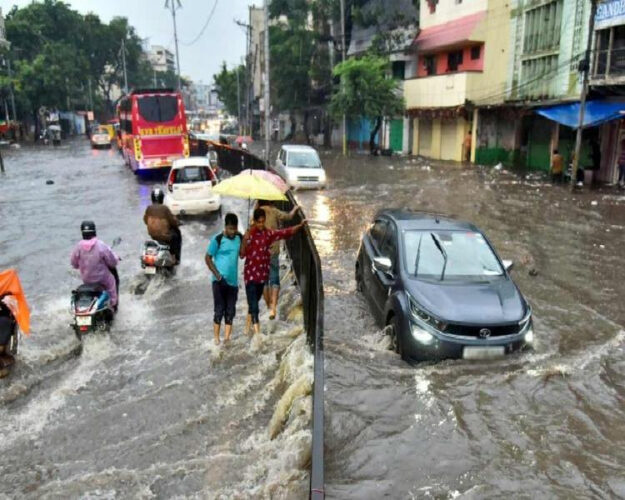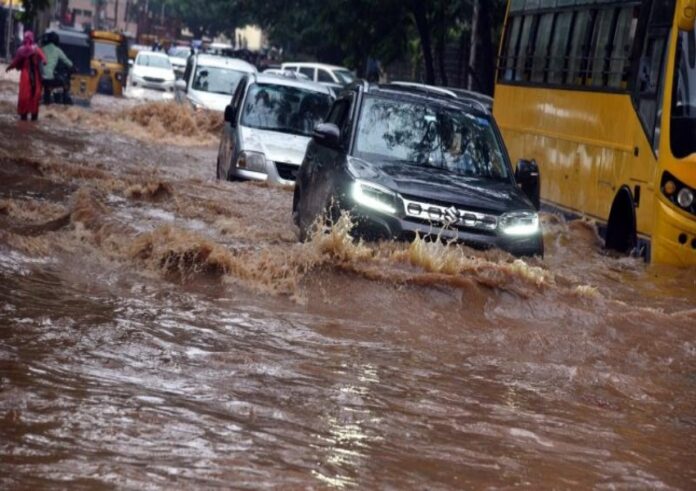The recent torrential rains in Hyderabad, several areas in the city came under the sheets of rainwater forcing people to spend sleepless nights as rainwater entered homes. These rains had not only impacted the low-lying areas across the city, but also the areas which never get flooded during rains.

Wondering why the roads seem more flooded this time around as opposed to the rains in July and August, when civic teams immediately cleared waterlogging?
The reason is that most of the 168 monsoon emergency teams, responsible for clearing water logging points, have disappeared from duty because their contractors have not paid them. The contractors are waiting for the GHMC to clear their pending bills.These teams, according to officials, should facilitate the free flow of rainwater and ensure there are no stagnation points, as well as alert people to potential hazards.
They were to remain on the ground until the end of October to clear water stagnation, check manholes, and storm water drains. However, the emergency team staffers have been on strike since September 15.
According to sources, the corporation has to pay contractors `800 crore for desilting and nala-related workers and the bills have not been cleared for a year though several representations were made to the corporation. As a result, the contractors have not paid wages to workers for at least six months.
Angered by this, monsoon emergency teams went on strike. There has been a lack of coordination among workers and contractors at the GHMC since. As a result, citizens have been deprived of clear roads when it rains. The strike has endangered the commuters who travel on dangerous roads, unable to identify manholes even on main roads that are covered in knee-deep water.
The GHMC was to station 160 static teams at 363 vulnerable points identified by the department. On Tuesday, several water stagnation points were found within a kilometre radius of the GHMC headquarters including at the Legislative Assembly, Basheerbagh, and Lakdikapul.

M. Sruthi, a commuter, said she was stuck in knee-deep water for nearly half-an-hour on the Basheerbagh-Tank Bund route and was afraid of falling into a manhole covered by rainwater. “I got stuck in knee-high water and couldn’t see anyone removing the stagnant water. Local police officers have diverted traffic via the city commissioners’ office. The knee-deep rain water on the main road posed a serious threat and I was worried about falling into a manhole.”
M. Manoj, who commutes to work on his two-wheeler, expressed concern, saying that the waterlogging at Lakdikapul has hampered not only him but all motorcycle commuters. Only heavy vehicles, he claimed, could pass through the water stagnation points. “I’ve paid taxes for what, to be stuck in hour-long traffic jams whenever it rains? Commuters have not received any help from the monsoon emergency teams and I could not spot anybody clearing the water clogging,” he said.
According to a senior GHMC official who requested anonymity, the corporation would deploy State Disaster Response Force teams in addition to disaster response teams deployed by the civic body. He stated that the corporation will be unable to clear pending bills for the contractors immediately, but that additional teams will be deployed.
on the otherside of this story, it is said that after the Hyderabad floods in Nizam’s dynasty, Nizam VI, Nawab Mir Mahboob Ali Khan constructed a stormwater drain system. Since then, this century-old stormwater drain system used to works and several areas in the Old city, never gets flooded in rains and no stagnation of water, and had also not during the Hyderabad witnessed floods in 2020 which damaged the city, but for last two years, these areas were being inundated in the sheet of rainwater. Residents and heritage activists blamed the civic body that they had disturbed the century-old stormwater drain system and now the areas are facing inundation.
According to the heritage activist, in each monsoon, where several areas of the city witnesses water inundation, this stormwater would not stagnate in the parts of Old city with the Nizam drain system in areas like Charminar, Moghalpura, Shalibanda, Khilwat, Purani Haveli, Fateh Darwaza, Hussaini Alam, Doodh Bowli, Kotla Alijah, Panch Mohalla, Pathergatti, Panjeshah, Qazipura, Afzal Gunj, Jumerat Bazar and several colonies of Golconda, the reason the century-old stormwater system which was constructed by the Nizam VI.

“During the heavy rains this year and on Monday, several areas were flooded even the areas which never saw inundation. Areas like Charminar – Moghalpura – Shalibanda – Hussaini Alam – Panch Mohalla – Pathergatti – Moazzamjahi Market – Mallepally and several others. Water entered in houses and the area was inundated with water. Water was up to 3-feet damaging the electronics and vehicles and children were seen swimming in rainwater in Mallepally,” said Mohammed Ahmed heritage activist.
Most of the localities in the Old City used to be dry and safe. “The Nizam system works to keep the Old City safe from stormwater stagnation. The system is still serving despite the increase in modernisation and population, but due to various other civic works the system was damaged. Rainwater could not free flow and was flooded for hours,” he pointed out.
“Each year, the monsoon action plan will be initiated by the civic body, which includes desilting of sewers and nalas, demolition drive of dilapidated structures and some other few works. But no proper plans and works were initiated. Several works were also incomplete. The government and city planners must take steps in the city to prevent rainwater inundation,” said Mohammed Asif Hussain, another activist. #KhabarLive #hydnews #hyderabadlive







